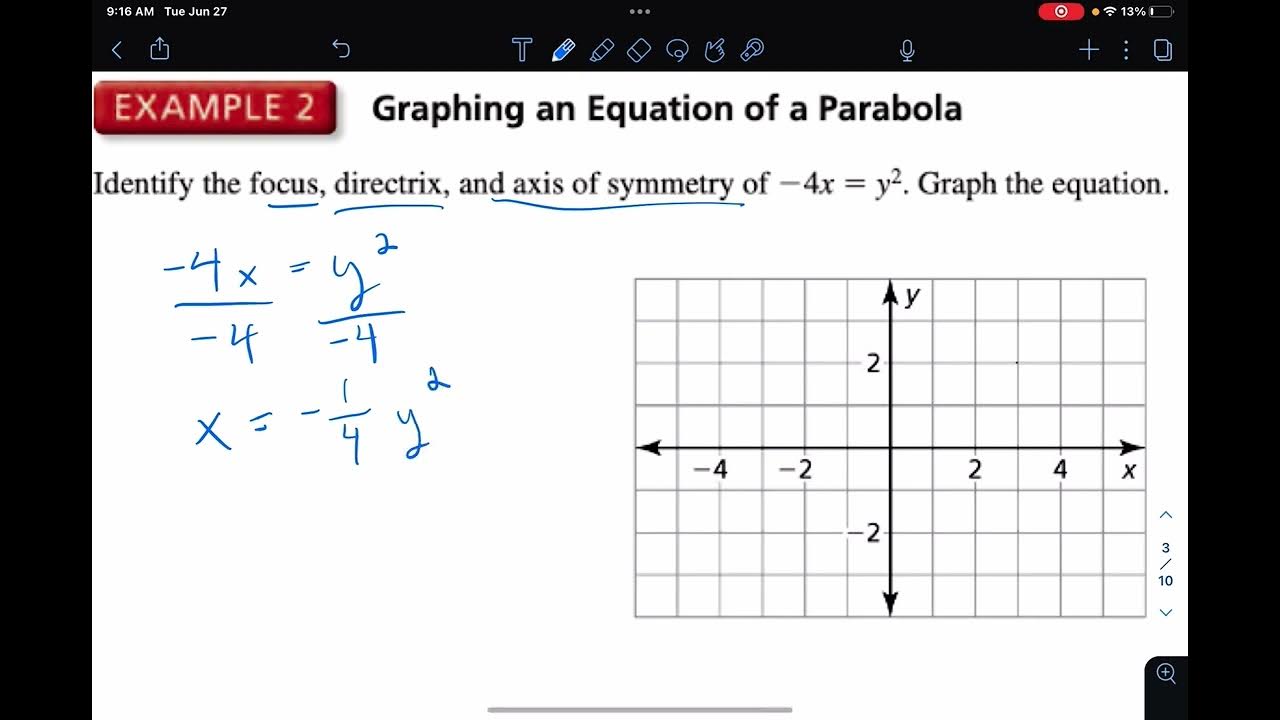Finding the Intersection of a Line with a Parabola
Summary
TLDRThis educational video script explores the concept of finding intersections between lines and parabolas algebraically and graphically. It begins by demonstrating how to visually identify intersection points between the line y=0 and the parabola y=x^2+4x. The script then transitions to solving intersection problems algebraically using systems of equations. Examples are provided to illustrate finding multiple intersection points, a single intersection, and scenarios where no intersection exists due to the nature of the equations. The process involves setting the equations equal to each other, simplifying, and solving for x, then substituting back to find corresponding y values. The script also touches on the use of the quadratic formula and the concept of imaginary numbers when no real intersection points are possible.
Takeaways
- 📚 The video discusses finding the intersection points of a line and a parabola using algebraic methods.
- 📈 The process involves setting up a system of equations where the equations represent the line and the parabola.
- 🔍 To find intersections graphically, the video shows plotting points and identifying where the line and parabola meet.
- 📝 For the algebraic method, the video demonstrates how to equate the y-values of the line and parabola and solve for x.
- 📉 The video provides step-by-step examples, starting with a simple case where the line y=0 intersects the parabola y=x^2+4x.
- 📊 In the examples, the video shows how to factor quadratic equations or use the quadratic formula to find the x-values of intersection points.
- 📐 The video emphasizes that the intersection points must satisfy both the equation of the line and the parabola.
- 🤔 The script highlights that there can be two, one, or no real intersection points depending on the equations involved.
- 📚 It's illustrated that when a quadratic equation yields no real solutions, the graphs of the line and parabola do not intersect.
- 📝 The video concludes by showing that the algebraic method is reliable for finding intersections, regardless of the complexity of the equations.
- 📈 The importance of understanding both graphical and algebraic approaches to solving intersection problems is emphasized.
Q & A
What is the process of finding the intersection of a line and a parabola?
-The process involves solving a system of equations. You set the equations representing the line and the parabola equal to each other and solve for the values of x and y that satisfy both equations, which gives you the intersection points.
What is the first equation used in the script to represent a line?
-The first equation used in the script to represent a line is Y = 0, which is a horizontal line crossing the y-axis at zero.
How is the parabola y = x^2 + 4x graphed in the script?
-The parabola is graphed by plotting points obtained by substituting different x values into the equation y = x^2 + 4x. The points are then connected to form the parabola shape.
What are the intersection points of the line Y = 0 and the parabola y = x^2 + 4x found in the script?
-The intersection points found are (0, 0) and (-3, -3), which are determined both graphically and algebraically.
What algebraic method is used to solve the system of equations representing the intersection of a line and a parabola?
-The algebraic method used involves setting the equations equal to each other and solving for x, then substituting the x values back into one of the original equations to find the corresponding y values.
How does the script demonstrate finding the intersection points algebraically for the equations Y = -2x + 1 and Y = -2x^2 + x + 28?
-The script sets the two equations equal to each other, simplifies to form a quadratic equation, and then solves for x using factoring or the quadratic formula. The x values are then substituted back into one of the original equations to find the y values, giving the intersection points.
What is a possible outcome when solving for the intersection of a line and a parabola?
-An outcome can be two points of intersection, one point of intersection, or no points of intersection if the line and parabola do not touch.
Why might a line and a parabola have only one point of intersection?
-A line and a parabola may have only one point of intersection if the line is tangent to the parabola, meaning they touch at exactly one point.
What does it mean when the quadratic formula yields a negative value under the square root?
-When the quadratic formula yields a negative value under the square root, it means that there are no real number solutions for x, and thus no real intersection points between the line and the parabola.
How can you verify the intersection points found algebraically?
-You can verify the intersection points by graphing both the line and the parabola on the same set of axes and visually checking where they intersect, or by plugging the x and y values of the intersection points back into the original equations to ensure they satisfy both.
Outlines

此内容仅限付费用户访问。 请升级后访问。
立即升级Mindmap

此内容仅限付费用户访问。 请升级后访问。
立即升级Keywords

此内容仅限付费用户访问。 请升级后访问。
立即升级Highlights

此内容仅限付费用户访问。 请升级后访问。
立即升级Transcripts

此内容仅限付费用户访问。 请升级后访问。
立即升级浏览更多相关视频

Solving Linear Systems Using SUBSTITUTION | Math10 | jensenmath.ca

NILAI MUTLAK PART I

Algebra 3 - Venn Diagrams, Unions, and Intersections

Übungsblatt6 – LGS mit 2 Unbekannten lösen und geometrische Interpretation Aufg.1c, e und f

Lines, Rays, Line Segments, Points, Angles, Union & Intersection - Geometry Basic Introduction

A2 Focus and Directrix
5.0 / 5 (0 votes)
